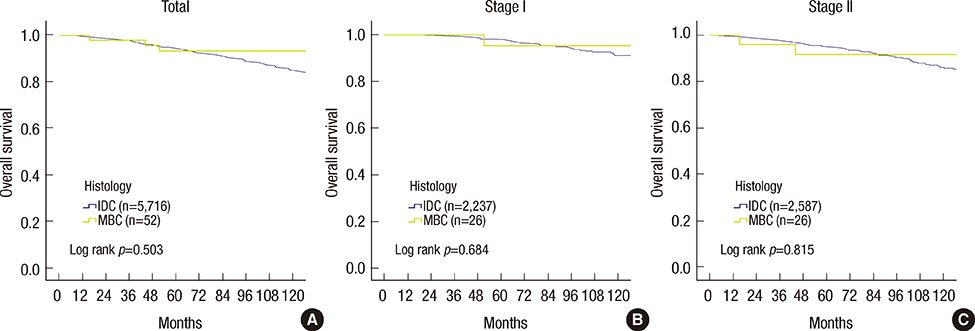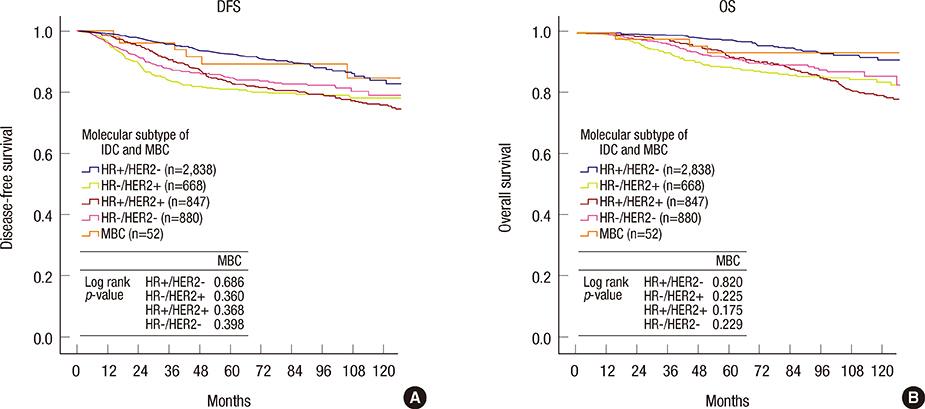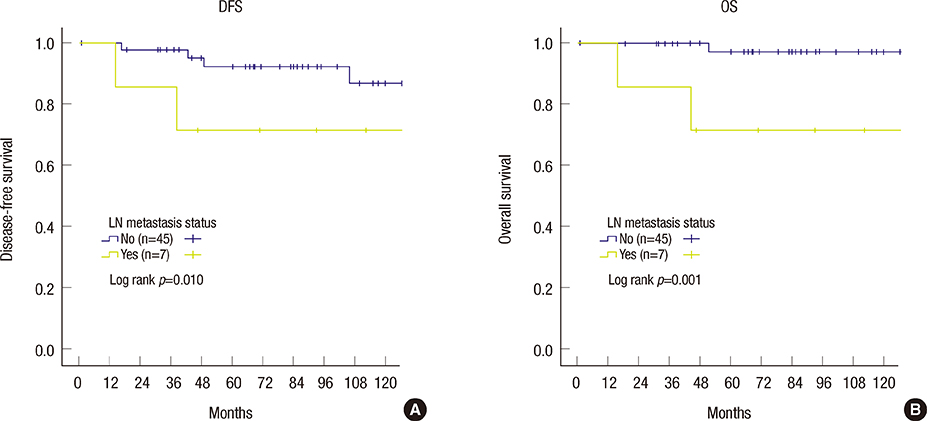J Breast Cancer.
2013 Dec;16(4):417-425. 10.4048/jbc.2013.16.4.417.
Comparison of the Characteristics of Medullary Breast Carcinoma and Invasive Ductal Carcinoma
- Affiliations
-
- 1Division of Breast and Endocrine Surgery, Department of Surgery, Samsung Medical Center, Sungkyunkwan University School of Medicine, Seoul, Korea. jeongeon.lee@samsung.com
- KMID: 1976380
- DOI: http://doi.org/10.4048/jbc.2013.16.4.417
Abstract
- PURPOSE
Medullary breast carcinomas (MBC) have been known to represent a rare breast cancer subtype associated with a more favorable prognosis than invasive ductal carcinomas (IDC). The purpose of this study was to compare the clinicopathologic characteristics and outcomes of MBC with those of IDC.
METHODS
We retrospectively reviewed medical records of patients with invasive breast cancer who were managed surgically from August 1995 to June 2010.
RESULTS
Fifty-two patients were identified with MBC and 5,716 patients were identified with IDC. The clinicopathologic features, disease-free survival (DFS), and overall survival (OS) of patients with MBC were compared with those of patients with IDC. The MBC group presented at a younger age (p=0.005) and had a significant association with a higher histological grade (p=0.003) and nuclear grade (p<0.001) as well as negative estrogen receptor (p<0.001) and progesterone receptor (p<0.001) status. Lymphatic invasion was absent (p<0.001) and lymph node metastasis was rare (p<0.001). The DFS and OS did not differ significantly between the two groups (5-year DFS: 88.0% vs. 89.2%, p=0.920; 5-year OS: 93.4% vs. 94.4%, p=0.503). In multivariate analysis, the factors associated with DFS and OS were nuclear grade, histological grade, tumor size, lymph node metastasis, estrogen receptor status, progesterone receptor status, and human epidermal growth factor receptor 2 status, chemotherapy, and hormone therapy. However, DFS and OS were not significantly different between IDC and MBC according to histological type itself (DFS: hazard ratio 0.85, 95% confidence interval 0.12-6.05, p=0.866; OS: hazard ratio 1.49, 95% confidence interval 0.21-10.77, p=0.692).
CONCLUSION
Although MBC has specific clinicopathologic features, its prognosis does not differ from IDC and is determined by prognostic factors such as tumor size and lymph node metastasis. Therefore, patients with MBC also require the same intensive treatment provided for IDC.
MeSH Terms
-
Breast Neoplasms
Breast*
Carcinoma, Ductal*
Carcinoma, Medullary
Disease-Free Survival
Drug Therapy
Estrogens
Humans
Lymph Nodes
Lymphatic Metastasis
Medical Records
Multivariate Analysis
Neoplasm Metastasis
Prognosis
Receptor, Epidermal Growth Factor
Receptors, Progesterone
Retrospective Studies
Estrogens
Receptor, Epidermal Growth Factor
Receptors, Progesterone
Figure
Reference
-
1. Tavassoli FA. Pathology of the Breast. 2nd ed. New York: McGraw-Hill;1999. p. 333–339.2. Abdul Rashid S, Rahmat K, Jayaprasagam K, Alli K, Moosa F. Medullary carcinoma of the breast: role of contrast-enhanced MRI in the diagnosis of multiple breast lesions. Biomed Imaging Interv J. 2009; 5:e27.
Article3. Li CI. Risk of mortality by histologic type of breast cancer in the United States. Horm Cancer. 2010; 1:156–165.
Article4. Weigelt B, Horlings HM, Kreike B, Hayes MM, Hauptmann M, Wessels LF, et al. Refinement of breast cancer classification by molecular characterization of histological special types. J Pathol. 2008; 216:141–150.
Article5. Moore OS Jr, Foote FW Jr. The relatively favorable prognosis of medullary carcinoma of the breast. Cancer. 1949; 2:635–642.
Article6. Cotran RS, Kumar V, Collins T, Robbins SL. Robbins Pathologic Basis of Disease. 6th ed. Philadelphia: Saunders;1999. p. 1111.7. Ridolfi RL, Rosen PP, Port A, Kinne D, Miké V. Medullary carcinoma of the breast: a clinicopathologic study with 10 year follow-up. Cancer. 1977; 40:1365–1385.
Article8. Foschini MP, Eusebi V. Rare (new) entities of the breast and medullary carcinoma. Pathology. 2009; 41:48–56.
Article9. Li CI, Uribe DJ, Daling JR. Clinical characteristics of different histologic types of breast cancer. Br J Cancer. 2005; 93:1046–1052.
Article10. Vu-Nishino H, Tavassoli FA, Ahrens WA, Haffty BG. Clinicopathologic features and long-term outcome of patients with medullary breast carcinoma managed with breast-conserving therapy (BCT). Int J Radiat Oncol Biol Phys. 2005; 62:1040–1047.
Article11. Vo T, Xing Y, Meric-Bernstam F, Mirza N, Vlastos G, Symmans WF, et al. Long-term outcomes in patients with mucinous, medullary, tubular, and invasive ductal carcinomas after lumpectomy. Am J Surg. 2007; 194:527–531.
Article12. Fisher ER, Anderson S, Redmond C, Fisher B. Pathologic findings from the National Surgical Adjuvant Breast Project protocol B-06: 10-year pathologic and clinical prognostic discriminants. Cancer. 1993; 71:2507–2514.
Article13. Ellis IO, Galea M, Broughton N, Locker A, Blamey RW, Elston CW. Pathological prognostic factors in breast cancer. II. Histological type. Relationship with survival in a large study with long-term follow-up. Histopathology. 1992; 20:479–489.
Article14. Oh JW, Park S, Kim JH, Koo JS, Hur H, Yang WI, et al. Clinical analysis of medullary carcinoma of the breast. J Breast Cancer. 2009; 12:47–53.
Article15. Rapin V, Contesso G, Mouriesse H, Bertin F, Lacombe MJ, Piekarski JD, et al. Medullary breast carcinoma. A reevaluation of 95 cases of breast cancer with inflammatory stroma. Cancer. 1988; 61:2503–2510.
Article16. Edge SB. American Joint Committee on Cancer. American Cancer Society. AJCC Cancer Staging Handbook: from the AJCC Cancer Staging Manual. 7th ed. New York: Springer;2010.17. Bloom HJ, Richardson WW. Histological grading and prognosis in breast cancer: a study of 1409 cases of which 359 have been followed for 15 years. Br J Cancer. 1957; 11:359–377.
Article18. Anderson WF, Chu KC, Chang S, Sherman ME. Comparison of age-specific incidence rate patterns for different histopathologic types of breast carcinoma. Cancer Epidemiol Biomarkers Prev. 2004; 13:1128–1135.19. Korean Breast Cancer Society. Breast Cancer Facts & Figures. Seoul: Korean Breast Cancer Society;2012.20. Flucke U, Flucke MT, Hoy L, Breuer E, Goebbels R, Rhiem K, et al. Distinguishing medullary carcinoma of the breast from high-grade hormone receptor-negative invasive ductal carcinoma: an immunohistochemical approach. Histopathology. 2010; 56:852–859.
Article21. Malyuchik SS, Kiyamova RG. Medullary breast carcinoma. Exp Oncol. 2008; 30:96–101.22. Kuroda H, Tamaru J, Sakamoto G, Ohnisi K, Itoyama S. Immunophenotype of lymphocytic infiltration in medullary carcinoma of the breast. Virchows Arch. 2005; 446:10–14.
Article23. Reinfuss M, Stelmach A, Mitus J, Rys J, Duda K. Typical medullary carcinoma of the breast: a clinical and pathological analysis of 52 cases. J Surg Oncol. 1995; 60:89–94.
Article24. Huober J, Gelber S, Goldhirsch A, Coates AS, Viale G, Öhlschlegel C, et al. Prognosis of medullary breast cancer: analysis of 13 International Breast Cancer Study Group (IBCSG) trials. Ann Oncol. 2012; 23:2843–2851.
Article25. Fisher ER, Kenny JP, Sass R, Dimitrov NV, Siderits RH, Fisher B. Medullary cancer of the breast revisited. Breast Cancer Res Treat. 1990; 16:215–229.
Article26. Thurman SA, Schnitt SJ, Connolly JL, Gelman R, Silver B, Harris JR, et al. Outcome after breast-conserving therapy for patients with stage I or II mucinous, medullary, or tubular breast carcinoma. Int J Radiat Oncol Biol Phys. 2004; 59:152–159.
Article27. Martinez SR, Beal SH, Canter RJ, Chen SL, Khatri VP, Bold RJ. Medullary carcinoma of the breast: a population-based perspective. Med Oncol. 2011; 28:738–744.
Article
- Full Text Links
- Actions
-
Cited
- CITED
-
- Close
- Share
- Similar articles
-
- Fine Needle Aspiration Cytology of Medullary Carcinoma of the Breast: A Case Report
- Pathologic Study of Breast Cancer in Korea
- Pathologic Study of Breast Cancer in Korea
- Apocrine Carcinoma of the Breast: The report of 2 cases
- Invasive Lobular Carcinoma of the Breast Associated with Mixed Lobular and Ductal Carcinoma In Situ: A Case Report





